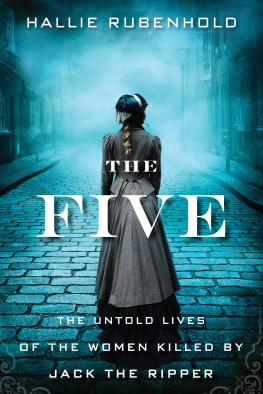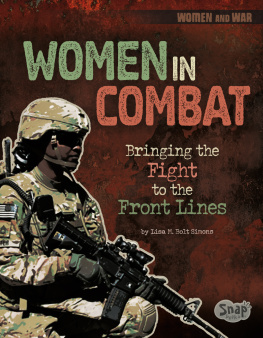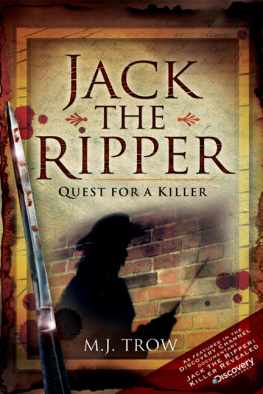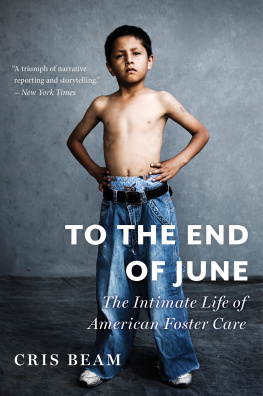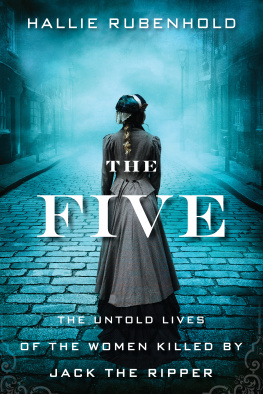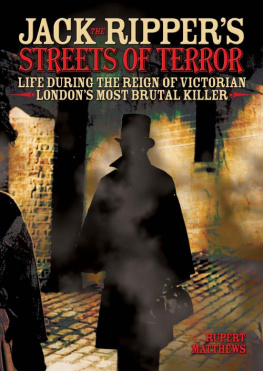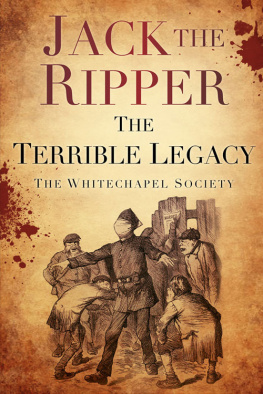
Copyright 2019 by Hallie Rubenhold
All rights reserved
For information about permission to reproduce selections from this book, write to or to Permissions, Houghton Mifflin Harcourt Publishing Company, 3 Park Avenue, 19th Floor, New York, New York 10016.
Published in the UK in 2019 by Transworld Publishers.
hmhbooks.com
Library of Congress Cataloging-in-Publication DataNames: Rubenhold, Hallie, author.Title: The five : the untold lives of the women killed by Jack the Ripper /Hallie Rubenhold.Description: Boston : Houghton Mifflin Harcourt, [2019] | Includes bibliographical references and index.Identifiers: LCCN 2018038562 (print) | LCCN 2018041373 (ebook) | ISBN 9781328664082 (ebook) | ISBN 9781328663818 (hardcover)Subjects: LCSH: Jack, the Ripper. | Murder victimsEnglandLondonBiography. | Working class womenEnglandLondonSocial conditions19th century. | Whitechapel (London, England)History19th century.Classification: LCC HV6535.G6 (ebook) | LCC HV6535.G6 L6578 2019 (print) |DDC 362.88dc23LC record available at https://lccn.loc.gov/2018038562
Cover design by Martha Kennedy
Front jacket photographs Richard Jenkins (woman) and Silas Manhood (street)
Author photograph Sarah Blackie
v1.0319
Map by Liane Payne, based on 1851 edition of Reynoldss Map of London
For
Mary Ann Polly Nichols,
Annie Chapman,
Elisabeth Stride,
Catherine Eddowes
&
Mary Jane Kelly
Introduction: A Tale of Two Cities
There are two versions of the events of 1887. One is very well known, but the other is not.
The first version, more frequently featured in history books, is the one that those who lived in late-nineteenth-century Britain wished to recall, the version they recounted to their grandchildren with a wistful smile. It is the story of Queen Victoria and a summer of celebrations for her Golden Jubilee. No more than a teenage girl when the nations weighty crown was placed upon her head, she had become, a half-century later, the embodiment of empire, and a suitably grand series of events had been planned to commemorate her fifty-year reign. On June 20, the precise day she had first mounted the throne, the crowned heads of Europe, Indian princes, dignitaries, and representatives from all corners of the empire, and even the Hawaiian queen, Liliuokalani, converged upon London. West End shopkeepers adorned their windows in red, white, and blue; Royal Standards and Union Jacks, festoons of flowers, and colored garlands could be seen hanging from every somber stone edifice. At night, the embassies and clubs, the hotels and institutions throughout St. James and Piccadilly threw the switches on the electric lights and turned on the gas jets, illuminating the giant crowns and the letters V and R affixed to their buildings. Her Majestys loyal subjects came to the center of the city from the suburbs and tenements; they punched their rail tickets from Kent and Surrey and pushed their way into the crowded streets, hoping to catch a glimpse of a royal coach or a princess in diamonds. They placed candles in their windows when the long summer twilight faded away, and toasted their monarchs health with beer and champagne and claret.
There was a service of thanksgiving at Westminster Abbey, a state banquet, a military review at Windsor, and even a childrens fete in Hyde Park for twenty-five hundred boys and girls. They were entertained by twenty Punch and Judy puppet shows, eight marionette theaters, eighty-six stereoscope displays, nine troupes of performing dogs, monkeys, and ponies, as well as bands, toys, and gas inflated balloons, before being treated to a lunch of lemonade, cake, meat pies, buns, and oranges. Throughout the summer there were commemorative concerts, lectures, performances, regattas, picnics, dinners, and even a yacht race. As the jubilee corresponded with the traditional London season, there were also lavish garden parties and balls. Ladies dressed up in that summers fashions: lace-trimmed, bustled dresses in black-and-white silk, and hues of apricot yellow, heliotrope, and Gobelin blue. A magnificent ball was held at the Guildhall, where the Prince and Princess of Wales entertained their visiting regal relations, as well as the prince of Persia, the papal envoy, the prince of Siam, and the Maharaja Holkar of Indore. All of high society danced beneath banners and cascading arrangements of perfumed flowers. Tiaras and tie pins sparkled in the mirrors. Young debutantes were introduced to suitable sons. The whirl of Victorian life spun round and round to the dreamy melody of a waltz.
Then there is the other version.
This is the tale of 1887 that most chose to forget. To this day, only a scant number of history books recount it, and surprisingly few people know that it occurred. Yet in that year, this story filled more newspaper column inches than did the descriptions of royal parades, banquets, and fetes put together.
That jubilee summer had been exceptionally warm and rainless. The clear blue skies that presided over the seasons carefree picnics and al fresco parties had shriveled the fruit harvest and dried out the fields. Water shortages and an absence of seasonal jobs in agricultural labor exacerbated an already growing employment crisis. While the wealthy enjoyed the fine weather from beneath their parasols and from under the trees of their suburban villas, the homeless and poor made use of it by creating an open-air encampment in Trafalgar Square. Many had come to the center of town, looking for work at Covent Garden Market, where Londoners bought their produce, but a drought meant fewer boxes of plums and pears to lift and haul. With no money for lodgings, these migrants slept rough in the nearby square, where they were joined by an increasing population of unemployed workers who would rather live on the street than face the deplorable and demeaning conditions of the workhouse. Much to the horror of more fortunate observers, these campers could be seen making their morning ablutions and scrubbing their vermin infested clothing in the fountains, directly beneath the nose of Lord Nelson, high atop his column. When the autumn chill began to move in, so too did the socialists, the Salvation Army, and various charitable organizations, handing out Bibles, admission tickets to lodging houses, coffee, tea, bread, and soup. Tarpaulins were erected to create makeshift bivouacs; each day, impassioned speakers declared their messages from between the paws of the squares mighty bronze lions. The excitement, the sense of community, and the free refreshments swelled the number of outcast Londoners, which attracted the police, which in turn brought the journalists. The newspapermen roamed among the squares bedraggled population, collecting their names and stories.
Mr. Ashville called himself a painter and glazier by trade. Out of work for twelve months, he had spent thirty-three nights sleeping on the Embankment until the weather grew too cold. Then he moved to Trafalgar Square, hoping it might prove a bit warmer. Dejected and visibly worn down by his experience, he attempted to remain positive about his prospects of finding employment again one day.
A soldiers widow circled Trafalgar Square, selling matches to support her young son, but she hadnt always lived like this. After failing to pay the final installment on her rent-to-own sewing machine, she lost her livelihood and the single room she had called home. She knew that going into the workhouse meant that her child would be separated from her. It seemed a better option to rough it in the square each night, with the boy curled up under her shawl.
Next page
